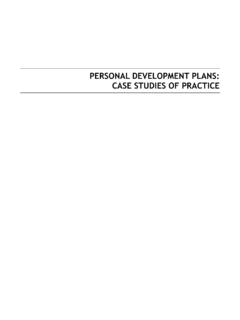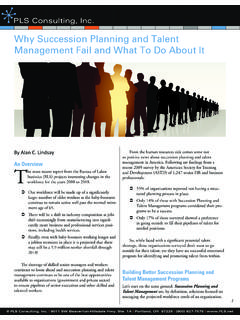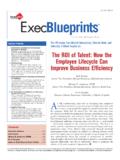Transcription of Talent Management: A Four-Step Approach
1 This IES report is based on research with 23 organisations in varied sectors. By speaking directly to practitioners, the study sought to identify how organisations are tackling Talent management and particularly the factors driving their choices. A Four-Step model is presented with the following core elements:n Definition: what do we mean by Talent management in this organisation?n Focus: which jobs and groups of people will Talent management focus on?n Process: how will Talent management be done in practice?n Action: what are the practical outcomes of Talent management?Choices in Approach were found to be very dependent on the business context. For each of the four steps, a set of business moderators was identified which seem to condition the choices made. These moderators concern the business drivers for Talent management, the business risks to be addressed, the capability of managers implementing the processes, and the measures the organisation will use to determine the impact of Talent report also offers a set of learning points, illustrated by practical examples in the text.
2 These include several aspects of how to align the Approach to Talent management with current and future business needs; balancing short-term with longer-term outcomes; consideration of organisational culture and the readiness of managers to support Talent identification and development. Successful implementation requires both the support of top leadership and the engagement of the wider HR community, not just Talent for Employment StudiesSovereign HouseChurch StreetBrighton BN1 1 UJTel: +44 (0) 1273 763400 Fax: +44 (0) 1273 Management: A Four-Step ApproachV Campbell, W HirshISBN 978 1 851844 500 Talent Management: A Four Step Approach V Campbell, W Hirsh Report 502 REpoRT 502 Talent Management: A Four-Step ApproachV Campbell, W HirshIES Report 502 Talent 106/09/2013 11:30 Talent MANAGEMENT A Four-Step Approach Other titles from IES: IES Perspectives on the HR Year Ahead 2013: interesting times IES Report 499, 2012 Organisational Values and the Role of HR.
3 A review of current thinking Culliney M, Robertson Smith G HR Network Paper MP92, 2013 The Engaging Manager Robinson D, Hayday S IES Report 470, 2009 Teams and the engaging manager Tamkin P, Robinson D IES Report 491, 2012 What Customers Want From HR: The views of line managers, senior managers and employees on HR services and the HR function Hirsh W, Carter A, Gifford J, Strebler M, Baldwin S Report 453 2008 Fish or Bird? Perspectives on Organisational Development (OD) Garrow V, Varney S, Lloyd C; IES Report 463, 2009 For more IES authored reports see Talent Management A Four-Step Approach Victoria Campbell Wendy Hirsh Published by: INSTITUTE FOR EMPLOYMENT STUDIES Sovereign House Church Street Brighton BN1 1UJ UK Tel. +44 (0) 1273 763400 Fax +44 (0) 1273 763401 Copyright 2013 Institute for Employment Studies No part of this publication may be reproduced or used in any form by any means graphic, electronic or mechanical including photocopying, recording, taping or information storage or retrieval systems without prior permission in writing from the Institute for Employment Studies.
4 British Library Cataloguing in Publication Data A catalogue record for this publication is available from the British Library ISBN 978 185184 450 0 Printed and bound in Great Britain by CPI Antony Rowe, Chippenham and Eastbourne Institute for Employment Studies IES is an independent, apolitical, international centre of research and consultancy in HR issues. It works closely with employers in all sectors, government departments, agencies, professional bodies and associations. IES is a focus of knowledge and practical experience in employment and training policy, the operation of labour markets, and HR planning and development. IES is a not for profit organisation. The IES HR Network This report is the product of a study supported by the IES HR Network, through which members finance, and often participate in, applied research on employment issues.
5 Full information on Network membership is available from IES on request, or at Acknowledgements The research reported here was conducted in the autumn of 2012 by Victoria Campbell. Victoria was at that time an NHS Management Trainee on secondment to IES to gain experience of other organisations and HR research. IES would like to thank Victoria for completing a challenging piece of research with great energy and commitment in a very short time frame. Victoria was supported in this project by Dilys Robinson and Wendy Hirsh. IES would like to thank all those in its HR Network member organisations who participated in this research and shared their experiences of Talent management so generously and frankly. Contents Executive Summary iv A Four Step Approach to Talent management iv An emergent field v Key learning points vi 1 Introduction to the Four Step Approach 1 Case based research on Talent management approaches 1 Key decisions and choices in developing Talent management: the Four Step Approach 2 2 Step One: Definition 4 Definition: What is Talent management?
6 4 Defining Talent management within wider people management 7 Drivers: Why is Talent management important? 10 3 Step Two: Focus 13 Focus: Where is Talent management needed? 13 Specific populations addressed by Talent management 13 Business risk: What issues are we addressing? 16 4 Step Three: Process 19 Process: How is Talent management done in practice? 19 Capability: Organisational responsibilities and readiness 24 5 Step Four: Action 31 Action: What are our practical outcomes? 31 Measurement: How will we assess impact? 34 6 Key Learning Points 38 References 40 iii Executive Summary A Four-Step Approach to Talent management IES conducted a case based study of issues and practices in Talent management in 23 member organisations of its HR Network. These were in a range of sectors including public, private and third sector organisations.
7 These discussions led to a Four Step model of Talent management as shown below. The Four-Step Approach to Talent Management Source: IES, 2013 The four steps which need consideration in the development of a Talent management Approach are: Definition: What do we mean by Talent management in this organisation? Focus: Which jobs and groups of people will Talent management focus on? Drivers Why is it important? Definition What is Talent management? Focus Business risk What issues are we addressing? Where do we need it? Capability Who is responsible? Are we ready? Process How will we do it in practice? Action What are our practical outcomes? Measurement How will we assess impact? iv Process: How will Talent management be done in practice? Action: What are the practical outcomes of Talent management? As shown in the figure above, each of the four steps also has a set of questions about the specific business which will condition the choices made at each step.
8 We call these business moderators and they go some way to explain why Talent management appears to be a highly contextual aspect of people management. They concern the business drivers for Talent management, the business risks it is hoping to address, the capability of managers implementing the processes and the measures the organisation will use to determine the impact of Talent management. While we acknowledge that this model is a simple view of a complex subject, it can help us understand how specific business needs influence Talent management in terms of its definition, focus, process and action. An emergent field Although Talent management has been a hot topic for at least 10 years, it was actually still quite embryonic in many of the organisations involved in this study. Some of the trends and issues included the following: There is difficulty with the definition and focus of Talent management, with quite a number of organisations sending messages about developing the Talent of the whole workforce but only really focusing on Talent for the most senior roles.
9 There is also growing interest in Talent for senior specialist roles and pipelines for occupations in scarce supply. The focus on the top of the organisation is reflected in definitions of high potential which tend to assess individuals against leadership behaviours. Often organisations focus on a grow your own Approach , where high potential employees quickly progress to fill senior positions and lead the development of the future workforce. Likewise most of the Talent programmes are for those with senior management potential, whether in mid career or in an early career accelerated development or graduate entry scheme. Some organisations are adopting much more individualised approaches to Talent development. The active development of those with potential takes some time to get established. It does rely on managers having both the capability and motivation to take real responsibility for developing their best people.
10 Organisations have ideas about how to track and measure the impact of Talent management, but tracking what happens to the individuals identified was not yet well embedded in most of the organisations in thi s study. v Key learning points Key learning points from this report include the following: 1. Adopt clear definitions and transparent processes: This will help gain trust and build credibility. 2. Be true to your definition and messages about Talent : If adopting an inclusive everyone has Talent Approach , ensure that the development review and planning processes for all staff genuinely reflect this. 3. Build the business case for Talent management: Align Talent development approaches to business strategy. 4. Be aware of changing business priorities: As business priorities change, we need to address whether our Talent management Approach is still appropriate.

















